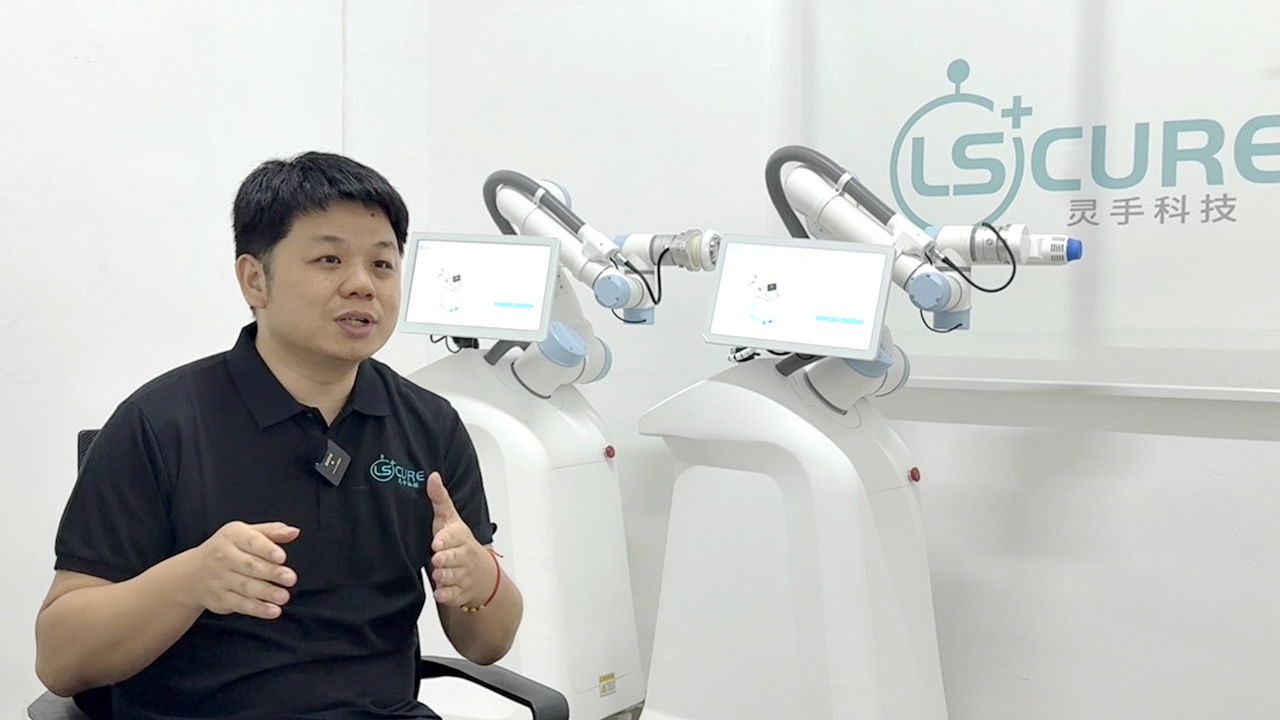LScure plans to bring robot masseurs into homes
Writer: Yu Yuanfan | Editor: Lin Qiuying | From: Original | Updated: 2025-05-12
Video and photos by Xu Shuntian
A stiff neck, tense muscles, and back pain — the prevalence of these conditions has made massage an indispensable part of many people’s lives. While masseurs remain popular, a new trend is rapidly emerging — receiving massages from machines with robotic arms. One of the companies dedicated to the popularization of robotic massage machines is Shenzhen-based LScure.
An opportunity spotted
Liu Zhilong, founder and CEO of LScure, has extensive experience in automation and medical robots. During his previous entrepreneurial venture, which involved developing robotic control technology for medical applications, he sensed untapped potential for robotic massage machines because the traditional massage industry faces numerous challenges, such as a shortage of skilled masseurs, difficulties in training practitioners, and a lack of industry standards.
 Liu Zhilong, founder and CEO of LScure, speaks during a recent interview with Shenzhen Daily at the company. (Inset) An LScure staffer selects options on the machine’s user interface before a massage session.
Liu Zhilong, founder and CEO of LScure, speaks during a recent interview with Shenzhen Daily at the company. (Inset) An LScure staffer selects options on the machine’s user interface before a massage session.
“It happened that, four to five years after I delved into the previous venture, the costs of core robotics parts dropped — due to an increase in domestic production — to a level we found affordable for developing robotic massage machines,” Liu shared with Shenzhen Daily during a recent interview. “So without much hesitation, we decided to venture into this market.”
In July 2021, he founded LScure in Bao’an District. One year later, the company launched its first robotic massage machine. Today, with subsidiaries in Hangzhou and Changsha, LScure has established a presence in different sectors of the health industry, from health monitoring and diagnosis to massage therapy.
Core technologies
LScure’s flagship products are a portfolio of robotic massage machines capable of delivering traditional Chinese medicine (TCM) massage treatments, including thermal therapy, shockwave therapy, cupping, moxibustion, and fascia massage. Its best-selling product features versatile treatment options with interchangeable modules.
A robotic massage begins with a therapist diagnosing a person’s physical condition with diagnostic software. Once the therapist determines the type of massage needed and the specific body parts to be treated, the robotic massage machine gives a massage based on the diagnosis.
The strength, temperature, and duration of treatment are determined by the machine, with human intervention available if the person has special needs. For those who receive robotic massages regularly, the machine can record their personal data for ongoing health monitoring.
For TCM massage therapists, accurately locating acupuncture points is a skill that requires substantial training and practice. For LScure’s robotic massage machines, however, their “expertise” is fueled by cutting-edge technology.
“In collaboration with Southern Medical University, we’ve developed robotic vision-based musculoskeletal positioning technology based on tens of thousands of visual data sets,” explained Liu. “With 3D reconstruction based on big data and AI training, the machine can sense the human body, precisely locate muscles and bones, and then find acupuncture points for massage.”
Because robotic massage involves close physical interaction between humans and machines, ensuring user safety remains a critical concern. According to Liu, LScure has achieved this through a combination of force sensors, visual guidance, and unique soft joints.

An LScure staffer enjoys a robotic massage session at the company recently.
“Our core technology is in soft robotics,“ said Liu. Such technology enables the development of robotic arms with great flexibility and adaptability. “We’ve also developed additional safety features for robotic joints. So besides compliant force control, we also have collision avoidance features to further ensure user safety.”
The company currently holds over 20 patents, including five invention patents.
A product for the future
With each robotic massage machine currently priced at around 100,000 yuan (US$14,000), LScure’s main customers are TCM clinics and beauty salons, including some in Southeast Asia, North America, and Europe.
According to Liu, the company is working to develop more affordable models priced at around 20,000 to 30,000 yuan and plans to further lower prices to make them accessible to average households.
“Currently, the market for robotic massage machines is still in its early stage. Only a very small fraction of people are aware of this product, so marketing education is essential,” said Liu.
“But its potential is enormous. With an aging population in most regions around the world, the demand for therapies is growing. Just like spa treatments, which used to be a luxury but are more affordable and enjoyed by the general public now, massage treatments will gradually become a routine for many to relax and rehabilitate.”
“The robotic massage machine is a product for the future,” he concluded.